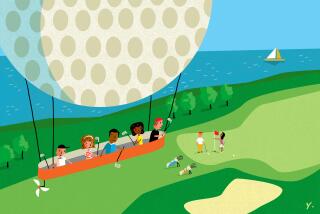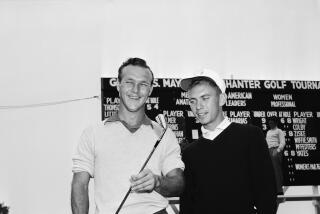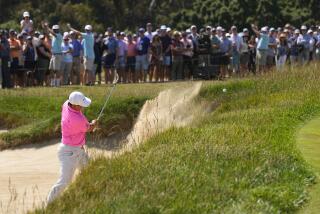WHEN LESS IS MORE
- Share via
We all know what we need to be the kind of golfers we keep telling everyone else we really are.
We need that three-wedge system to spin the ball back into the cup from any distance inside 100 yards. We need that deep-faced, lightweight titanium driver to get into trouble and the low-profile multimetal three-wood to get out of it. We need all 14 clubs we’re allowed to carry and, by golly, even that isn’t enough sometimes.
We know we need these things because we read in glossy golf magazines that we’re inadequate without them. Infomercials and ads on TV promote new, longer-hitting clubs that render the ones we have in our bags obsolete. We’re told over and over that the clubs make the golfer, that the more of those magic sticks you have the better you’ll play.
Baloney.
We’ve all been hornswoggled by the golf industry, hoodwinked by Madison Avenue into thinking we need much more than we do. Do we need quality equipment? Sure. Do we need lots of it? Not really. What we actually need is less clutter on the course, not more.
How many clubs does it take to adequately negotiate most regulation layouts? I’d say five, six tops--including your putter.
Two weeks ago, my regular golf buddy and I played at San Dimas Canyon golf course, a nice, 6,300-yard layout in the San Gabriel foothills. Pretty course to walk, scenic with rolling terrain but no severe hills. We had decided to leave our bags in the car and take only a handful of clubs. I took a three-wood, five-iron, nine-iron and a putter; Steve took only a driver, five-iron and wedge. (Steve’s a better friend than he is a putter; he used his driver on the greens and maintained his usual sharpness.)
How’d we do? I could have had every club in Roger Dunn’s Superstore and I wouldn’t have scored any lower. I shot an 84, which isn’t remarkable but is better by several shots than I had been playing for the last few months. Steve had a passable 90, not far off his usual round.
Never were we in a sniggly situation where one of our clubs wasn’t adequate. If I had a 60-yard shot to the pin, I hit an easy nine-iron; a 140-yard shot, an easy five-iron; 185 yards, an easy three-wood. Get it? Easy. You have no option but to back off on your swing when you have only a few clubs, and that leads to better contact with the ball.
Playing golf with only a few clubs accomplishes a couple of things. You are forced to swing easily most of the time. And if you walk rather than ride, after carrying only a handful of clubs for 18 holes, you feel as though you have taken the dog for a stroll rather than spent four hours as a hod carrier.
Consider this: A mid-handicap golfer will usually hit no more than three or four shots squarely during a round. The other 50 or so swings, excluding putts, are mis-hits. And many of those mis-hits come after we have to make decisions between two clubs. Because all of us think we are better than we really are, that the exceptionally good shots we occasionally hit are the norm, we almost always make the wrong choice.
We wage an internal debate: “Do I ease up on the five-iron or smack the six, ‘cause I know if I hit a pure six, I’m gonna be all over the pin.” And that’s all it takes to convince ourselves. We clench our teeth, grip the club like we’re trying to squeeze the last dollop of toothpaste out of the tube and hit a fat six-iron. The ball plugs in the bunker at the front of the green, our sand shot flies to the back fringe and we three-putt for double bogey. By over-swinging once, we’ve cost ourselves two shots.
If you eliminate most of your clubs, you reduce the chances of making the kind of bad decisions that define most of us as hackers. You simplify the game.
Mike Davis, a PGA Class-A professional at Pelican Hill Golf Club in Newport Beach, occasionally ran three- and four-club tournaments at a private club where he used to work and considered them valuable teaching tools. “Our members almost always were close to or right at their handicaps,” he says of those tournaments. “You tend to focus on making the shot instead of mechanics, tend to be more creative.
“You’re feeling the shots instead of hitting them.”
A week ago I returned to San Dimas. It was a beautiful morning and I headed out early with my full set of clubs. Armed with the easy-swinging lesson of the week before, my only question at the start was whether I’d break 80.
I missed a few putts and shot a 40 on the front without over-swinging once. Sam Snead had never swung more effortlessly.
But something happened on the back side. I came to the par-four 11th hole and reached back for a little extra. Heck, I was feeling the shots; I was ready for some power with the glory. I yanked my tee shot out of bounds. The triple bogey that followed was a result of one mental bogey; the following seven holes were a series of them. The easy swing was gone. “I know if I hit a pure six-iron . . . “
By the time I was trudging up the 18th fairway, my bag had become an albatross. I finished with an 87.



